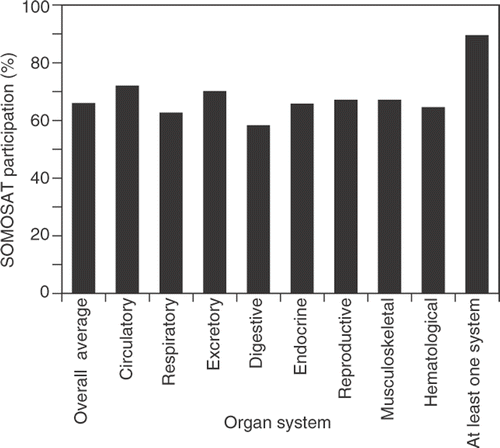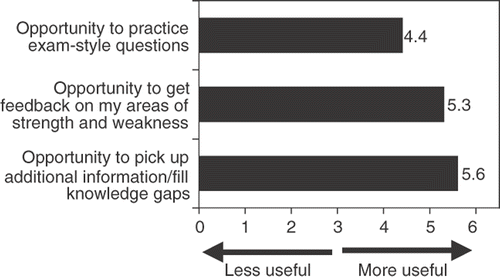Figures & data
Figure 1. The SOMOSAT participation (% of the class) by organ system. Organ systems are presented in the chronological order in which the modules became available to students (i.e. beginning with the circulatory and ending with the haematological system).

Figure 2. Correlations between SOMOSAT score (% correct), and performance on the graded course examinations, for the circulatory (a), respiratory (b) and digestive (c) system modules.

Figure 3. Graded Course Examination Scores (% correct) for SOMOSAT participants vs. non-participants for all organ system modules. (*p < 0.05 vs. SOMOSAT non-participants; **p < 0.001 vs. SOMOSAT non-participants overall).

Figure 4. Inverse correlation between score improvement (Graded Course Examination Score minus SOMOSAT Score) vs. SOMOSAT score in the circulatory system module for the three disciplines of pathophysiology (a), pathology (b) and pharmacology (c) and three representative circulatory system subtopics: Arrhythmias (d), Congestive Heart Failure (e) and Ischemia/Infarction (f). (n = 115 for all panels, however, multiple data points are overlapping due to students receiving similar combinations of scores.

Figure 5. Graded Course Examination Scores as a function of the degree of participation in SOMOSAT for the circulatory (a) and musculoskeletal system (b) modules. Quiz + R1 = Quiz Mode and Initial Review Mode only; Quiz + R1 + R2 = Quiz Mode, Initial Review Mode and Final Review Mode.

Figure 6. Student feedback about the specific aspects of SOMOSAT that were most helpful in learning and studying. Responses are recorded on a Likert scale.

Table 1. Student comments regarding SOMOSAT